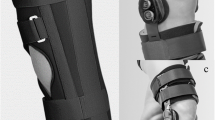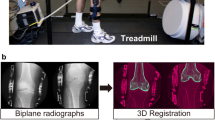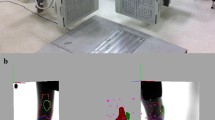Abstract
Purpose
The purpose of this study was to investigate whether knee braces could effectively decrease tibial rotation during high demanding activities.
Methods
Using an in vivo three-dimensional kinematic analysis, 21 physically active, healthy, male subjects were evaluated. Each subject performed two tasks that were used extensively in the literature because they combine increased rotational and translational loads on the knee, (1) descending from a stair and subsequent pivoting and (2) landing from a platform and subsequent pivoting under three conditions: (A) wearing a prophylactic brace (braced), (B) wearing a patellofemoral brace (sleeved), and (C) unbraced condition.
Results
In the first task, tibial rotation during the pivoting phase was significantly decreased in the braced condition as compared to the sleeved condition (P = 0.019) and the non-braced condition (P = 0.002). In the second task, the same variable was significantly decreased in the braced condition as compared to the sleeved (P = 0.001) and the unbraced condition (P < 0.001). The sleeved condition also produced significantly decreased tibial rotation with respect to the unbraced condition (P = 0.021).
Conclusions
Bracing decreased tibial rotation in activities where increased translational and rotational forces were applied. Because knee braces decreased tibial rotation, they can possibly be used with ACL-reconstructed and ACL-deficient patients to prevent such problems.
Level of evidence
Case–control study, Level III.





Similar content being viewed by others
References
Andriacchi TP, Andersson GB, Fernier RW et al (1980) A study of lower-limb mechanics during stair-climbing. J Bone Joint Surg Am 62:749–757
Aroll B, Ellis-Pegler E, Edmonds A, Sutcliffe G (1997) Patellofemoral pain syndrome: a critical review of the clinical trials on nonoperative therapy. Am J Sports Med 25:207–212
Bedi A, Musahl V, O`Loughlin P, Maak T, Citak M, Dixon P, Pearle AD (2010) A comparison of the effect of central anatomical single-bundle anterior cruciate ligament reconstruction and double-bundle anterior cruciate ligament reconstruction on pivot-shift kinematics. Am J Sports Med 38:1788–1794
Beynnon BD, Fleming BC, Churchill DL, Brown D (2003) The effect of anterior cruciate ligament deficiency and functional bracing on translation of the tibia relative to the femur during nonweightbearing and weightbearing. Am J Sports Med 31:99–105
Beynnon BD, Johnson RJ, Fleming BC, Pleura GD, Renstrom PA, Nichols CE, Pope MH (1997) The effect of functional knee bracing on the anterior cruciate ligament in the weightbearing and non weightbearing knee. Am J Sports Med 25:353–359
Beynnon BD, Pope MH, Wertheimer CM, Johnson RJ, Fleming BC, Nichols CE, Howe JG (1992) The effect of functional knee-braces on strain on the anterior cruciate ligament in vivo. J Bone Joint Surg Am 74:1298–1312
Branch TP (1989) Dynamic EMG analysis of anterior cruciate deficient legs with and without bracing during cutting. Am J Sports Med 17:35–41
Cawley PW, France EP, Paulos LE (1989) Comparison of rehabilitative knee braces. A biomechanical investigation. Am J Sports Med 17:141–146
Cawley PW, France EP, Paulos LE (1991) The current state of functional knee bracing research. A review of the literature. Am J Sports Med 19:226–233
Chambers HG, Sutherland DH (2002) A practical guide to gait analysis. J Am Acad Orthop Surg 10:222–231
Cook FF, Tibone JE, Redfern FC (1989) A dynamic analysis of a functional brace for anterior cruciate ligament insufficiency. Am J Sports Med 17:519–524
Davis R, Ounpuu S, Tyburski D et al (1991) A gait analysis data collection and reduction technique. Hum Move Sci 10:575–587
Decker M, Torry M, Nooman T, Riviere A, Sterett W (2002) Landing adaptations after ACL reconstruction. Med Sci Sports Exerc 34:1408–1413
DeVita P, Hunter PB, Skelly WA (1992) Effects of a functional knee brace on the biomechanics of running. Med Sci Sports Exerc 24:797–806
France EP, Paulos LE (1994) Knee bracing. J Am Acad Orthop Surg 2:281–287
Georgoulis AD, Papadonikolakis A, Papageorgiou CD, Mitsou A, Stergiou N (2003) Three-dimensional tibiofemoral kinematics of the anterior cruciate deficient and reconstructed knee during walking. Am J Sports Med 31:75–79
Georgoulis AD, Ristanis S, Chouliaras V, Moraiti C, Stergiou N (2007) Tibial rotation is not restored after ACL reconstruction with a hamstring graft. Clin Orthop Relat Res 454:89–94
Grood ES, Suntay WJ (1983) A joint coordinate system for the clinical description of three-dimensional motions: application to the knee. J Biomech Eng 105:136–144
Harner CD, Poehling GG (2004) Double bundle or double trouble? Arthroscopy 20:1015–1025
James CR, Bates BT, Dufek JS (2003) Classification and comparison of biomechanical response strategies for accommodating landing impact. J Appl Biomech 19:106–118
Kanamori A, Zeminski J, Rudi TW, Li G, Fu FH, Woo SL (2002) The effect of axial tibial torque on the function of the anterior cruciate ligament: a biomechanical study of a simulated pivot shift test. Arthroscopy 18:394–398
Knutzen KM, Bates BT, Hamill J (1983) Electrogoniometry of post-surgical knee bracing in running. Am J Phys Med 62:172–181
Kondo E, Merican AM, Yasuda K, Amis AA (2010) Biomechanical comparisons of knee stability after anterior cruciate ligament reconstruction between 2 clinically available transtibial procedures: anatomic double bundle versus single bundle. Am J Sports Med 38:1349–1358
Kramer JF, Dubowitz T, Fowler P, Schachter C, Birmingham T (1997) Functional knee braces and dynamic performance: a review. Clin J Sport Med 7:32–39
Lucchetti L, Cappozzo A, Cappello A, Crose UD (1998) Skin movement artefact assessment and compensation in the estimation of knee-joint kinematics. J Biomech 31:977–984
McNair P, Marshall R (1994) Landing characteristics in subjects with normal and anterior cruciate ligament deficient knee joints. Arch Phys Med Rehabil 75:584–589
Paluska SA, McKeag MD (2000) Knee braces: current evidence and clinical recommendations for their use. Am Fam Physician 61:411–418
Perlau R, Frank C, Fick G (1995) The effect of elastic bandages on human knee proprioception in the uninjured population. Am J Sports Med 23:251–255
Ramsey DK, Wretenberg PF, Lamontagne M, Nιmeth G (2003) Electromyographic and biomechanic analysis of anterior cruciate ligament deficiency and functional knee bracing. Clin Biomech 18:28–34
Reinschmidt C, Bogert AVD, Nigg B, Lundberg A, Murphy N (1997) Effect of skin movement on the analysis of skeletal knee joint motion during running. J Biomech 30:729–732
Ristanis S, Giakas G, Papageorgiou CD, Moraiti T, Stergiou N, Georgoulis AD (2003) The effects of anterior cruciate ligament reconstruction on tibial rotation during pivoting and descending stairs. Knee Surg Sports Traumatol Arthrosc 11:360–365
Ristanis S, Stergiou N, Patras K, Tsepis E, Moraiti C, Georgoulis AD (2006) Follow up evaluation 2 years after ACL reconstruction with bone—patellar tendon—bone graft shows that excessive tibial rotation persists. Clin J Sport Med 16:111–116
Ristanis S, Stergiou N, Patras K, Vasiliadis HS, Giakas G, Georgoulis AD (2005) Excessive tibial rotation during high demanding activities is not restored by ACL reconstruction. Arthroscopy 21:1323–1329
Sitler M, Ryan J, Hopkinson W, Wheeler J, Santomier J, Kolb R, Polley D (1990) The efficacy of a prophylactic knee brace to reduce knee injuries in football. A prospective, randomized study at West Point. Am J Sports Med 18:310–315
Stergiou N, Bates BT, James SL (1999) Asynchrony between subtalar and knee joint function during running. Med Sci Sports Exerc 31:1645–1655
Teitz CC, Hermanson BK, Kronmal RA, Diehr PH (1987) Evaluation of the use of braces to prevent injury to the knee in collegiate football players. J Bone Joint Surg Am 69:2–9
Theoret D, Lamontagne M (2006) Study on three-dimensional kinematics and electromyography of ACL deficient knee participants wearing a functional knee brace during running. Knee Surg Sports Traumatol Arthrosc 11:555–563
Tsai AG, Wijdicks CA, Walsh MP, Laprade RF (2010) Comparative kinematic evaluation of all-inside single-bundle and double-bundle anterior cruciate ligament reconstruction: a biomechanical study. Am J Sports Med 38:263–272
Vailas JC, Pink M (1993) Biomechanical effects of functional knee bracing. Practical implications. Sports Med 15:210–218
Vergis A, Gillquist J (1998) Sagittal plane translation of the knee during stair walking. Comparison of healthy and anterior cruciate ligament-deficient subjects. Am J Sports Med 26:841–846
Wojtys EM, Kothari SU, Huston LJ (1996) Anterior cruciate ligament functional brace in sports. Am J Sports Med 24:539–546
Wojtys EM, Loubert PV, Samson SY, Viviano DM (1990) Use of a knee-brace for control of tibial translation and rotation. A comparison, in cadavera, of available models. J Bone Joint Surg Am 72:1323–1329
Wright RW, Fetzer GB (2007) Bracing after ACL reconstruction. A systematic review. Clin Orthop Relat Res 455:162–168
Acknowledgments
The authors gratefully acknowledge the support from the General Secretariat for Research and Technology (Operative Program Competitiveness; AKMON) to the Orthopaedic Sports Medicine Center and the Nebraska Research Initiative to Dr. Nicholas Stergiou.
Author information
Authors and Affiliations
Corresponding author
Rights and permissions
About this article
Cite this article
Giotis, D., Tsiaras, V., Ristanis, S. et al. Knee braces can decrease tibial rotation during pivoting that occurs in high demanding activities. Knee Surg Sports Traumatol Arthrosc 19, 1347–1354 (2011). https://doi.org/10.1007/s00167-011-1454-8
Received:
Accepted:
Published:
Issue Date:
DOI: https://doi.org/10.1007/s00167-011-1454-8




